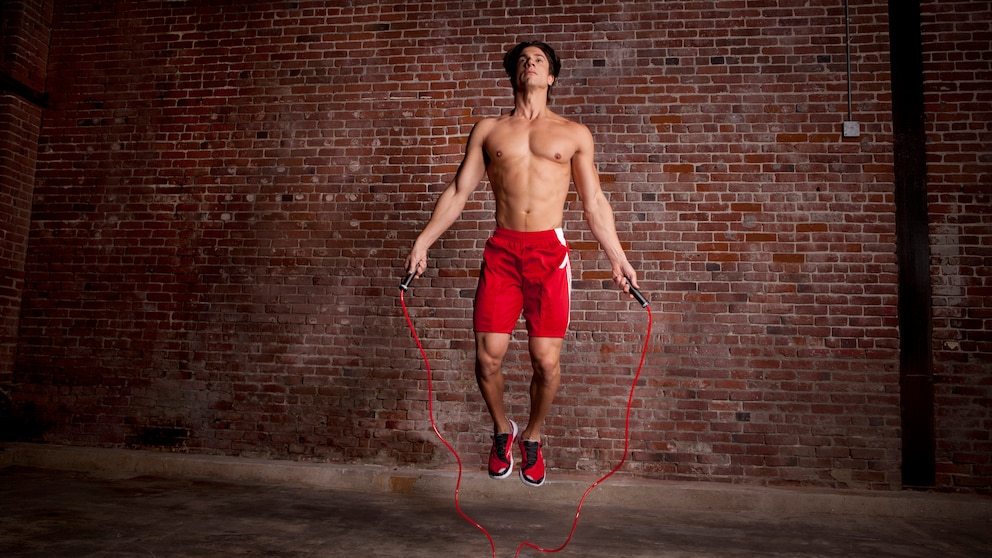February 10, 2025, 4:34 pm | Read time: 5 minutes
Setting off on a run without a proper and specific warm-up is anything but advisable. Muscles and connective tissue should be brought up to operating temperature beforehand, and the same applies to the mind. Skipping is the ideal preparation for this. FITBOOK author Tony Poland asked an expert why this is the case.
Skipping and running are two easy-to-implement and effective sports for increasing basic physical fitness and improving endurance. The two disciplines not only work separately but also together. Skipping’s form as a full-body workout alone warms up many different muscles and muscle groups, which are later also heavily used when jogging. In short, it’s the perfect warm-up before a running session. Sports scientist, personal trainer, and alternative practitioner Markus Bremen revealed to FITBOOK the other benefits that can be directly transferred to the demands of running.
Overview
Arguments for Skipping
Activation of the Muscles
When skipping, the movement sequence primarily strengthens the foot and calf muscles..1 And ultimately, we need the same muscles when running, especially for pushing off and cushioning the impact. “In addition, more pronounced calf and shin muscles also improve running economy,” emphasizes the expert. This describes how efficiently a runner moves – in other words, how much of the energy used is invested directly into effective propulsion and how much is wasted through unnecessary or physically unfavorable movement patterns.
“In addition, the core, especially the lower core area, should not be underestimated,” emphasizes Markus Bremen. “It absorbs all the impact loads so that we don’t hit our spine when we land, for example. This area is also warmed up well,” says the personal coach. This is because the core (trunk muscles) is activated by the stability required when jumping. When jogging, on the other hand, it is essential to have the best possible posture.
Ultimately, all of this means that you don’t overexert yourself too quickly or, in the worst case, injure yourself. The formula in this context is simple: warmed-up target muscles equal fewer injuries!
Promoting Running Style and Explosiveness
Warming up your muscles is not just a preventative measure; it also has an impact on your running style. Because this improves it considerably. The expert explains: “It makes running more springy, which is much more advisable anyway. A runner should land as midfoot-oriented as possible in order to be able to push off further directly forward. This allows them to work in an energy-efficient manner. Skipping is a great way to achieve this.”
Incidentally, when muscles and tendons are warm and prepared, explosiveness is also increased because you can push off much better.
Warming up the Passive Connective Tissue
But that’s not the only reason why skipping as a warm-up also warms up tendons and ligaments and, therefore, the passive connective tissue. “These are all the structures that runners tend to overstretch or tear because they haven’t warmed up properly,” says the fitness trainer. They are then simply too cold and are exposed to too much strain.
Nevertheless, the lack of focus on the passive musculoskeletal system is a mistake that beginners and advanced athletes alike often make. Especially after a long break: “They then jump straight back in and carry on where they started. That’s difficult, of course,” warns Markus Bremen.
Improving Coordination with Skipping
Although the arm and leg movements when skipping are, of course, not one hundred percent identical to those when running, there is still a certain degree of overlap. After all, in both cases, the movement sequences between the hands, feet, and eyes have to be coordinated correctly. “And the fact that these paths are prepared in advance is, of course, ideal for the motor system – i.e., the neurological preparation for the brain and target muscles,” says Markus Bremen. Overall body control is therefore stimulated in advance, which can help enormously, especially when jogging on uneven terrain.
Strengthening the Cardiovascular System
“Cardiovascular fitness is also trained through rope skipping and running,” the fitness specialist introduces the final point. Why? “You get a very high and steep increase in your heart rate in a very short time when skipping. It goes up extremely quickly because so many whole-body muscles are used and you move your entire body,” explains Markus Bremen.
Later, during a faster run, the heart is put under greater strain, thereby increasing its pumping capacity. The muscles are supplied with oxygen more efficiently and the resting pulse rate and heart rate drop under physical exertion. In summary, this strengthens your cardiovascular system and therefore also your cardiovascular endurance.

Advantages and disadvantages explained by an expert Bench press – better on the machine, with free weights, or with a barbell?

For basic fitness How long men and women should be able to swim

Animal Moves Learn the Spiderman walk in 5 steps
What a Warm-up with Skipping Could Look Like
To be perfectly prepared for running, it is important to find a healthy balance. In other words, overexertion during the warm-up and total exhaustion are to be avoided, and one should not expend excessive energy. Of course, it should serve its purpose.
“I would suggest that beginners skip for around three to five minutes beforehand. Then they can assume that they are well warmed up to start running slowly,” recommends Markus Bremen. Better-trained people can also jump for five to ten minutes. But take it easy and quietly with normal and light jumps!

